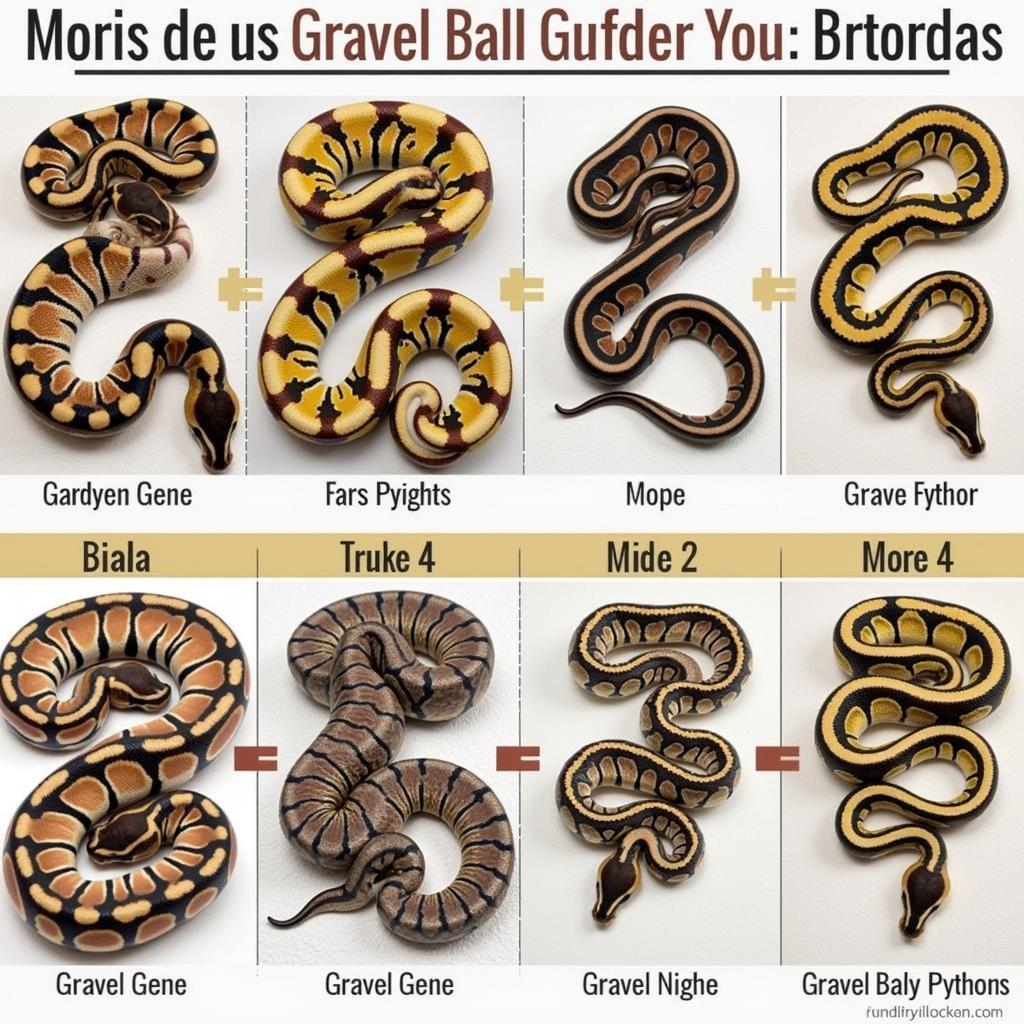Gravel Ball Python: A Comprehensive Guide
November 7, 2024Gravel Ball Pythons are a fascinating morph of the popular ball python species, known for their unique pattern and texture. These snakes are highly sought after by reptile enthusiasts due to their striking appearance and relatively docile nature. This guide will delve into everything you need to know about gravel ball pythons, from their genetics and care requirements to their potential market value.
Understanding the Gravel Gene
The gravel gene is a recessive mutation that affects the ball python’s pattern and scalation. It creates a speckled, textured appearance, resembling small pebbles or gravel, hence the name. The pattern can vary significantly between individual snakes, with some exhibiting a high contrast between the base color and the gravel pattern, while others have a more subtle, blended look. This variation adds to the appeal of gravel ball pythons, making each one a unique individual. The gravel gene can also interact with other morphs, creating even more diverse and visually stunning combinations.
What makes the gravel morph particularly interesting is its interaction with other genes. Combining gravel with other morphs can lead to stunning visuals, making it a popular choice for breeders looking to create unique and desirable snakes. For instance, pairing a gravel ball python with a pastel morph can result in a softer, more diffused gravel pattern.
 Close-up view of a gravel ball python's unique scales
Close-up view of a gravel ball python's unique scales
Caring for a Gravel Ball Python
Caring for a gravel ball python is similar to caring for any other ball python morph. They require a controlled environment with appropriate temperature and humidity levels. A temperature gradient is essential, with a warm side maintained at around 90°F (32°C) and a cooler side at around 78°F (26°C). Humidity should be kept between 50% and 60% to prevent shedding problems. Providing a variety of hides and climbing branches is crucial for their well-being, allowing them to feel secure and explore their enclosure. A suitable substrate, such as aspen shavings or cypress mulch, helps maintain humidity and allows for natural burrowing behavior.
Feeding a gravel ball python is straightforward. They primarily feed on rodents, and the size of the prey should be appropriate for the snake’s size. Young snakes should be fed smaller prey items more frequently, while adults can be fed larger prey items less often. Regular cleaning of the enclosure is essential for hygiene and to prevent the buildup of bacteria or parasites.
Gravel Ball Python Morphs and Genetics
The gravel gene’s recessive nature means that both parent snakes must carry the gene for offspring to express the gravel morph visually. Breeding two gravel ball pythons guarantees gravel offspring. If only one parent carries the gene, the offspring will be het gravel, meaning they carry the gene but do not visually express it. These het gravel individuals can then be bred to produce gravel offspring in future generations. Understanding these genetic principles is crucial for breeders aiming to produce specific morph combinations.
Breeding gravel ball pythons with other morphs can lead to a wide array of combinations. For example, combining gravel with the albino gene results in an albino gravel ball python, which exhibits the characteristic white or pink coloration of the albino morph along with the textured gravel pattern.
What is the genetic makeup required for a gravel ball python? Both parents must carry the recessive gravel gene.
 Comparison of different gravel ball python morphs
Comparison of different gravel ball python morphs
Conclusion
The gravel ball python, with its unique and captivating appearance, is a rewarding addition to any reptile collection. Understanding their care requirements and genetic principles is essential for ensuring their health and well-being. Whether you are a seasoned reptile keeper or just starting out, the gravel ball python offers a fascinating glimpse into the world of reptile morphs. If you are considering adding a gravel ball python to your family, remember to research reputable breeders and prioritize the snake’s health and welfare.
FAQ
- What is the average lifespan of a gravel ball python? (20-30 years)
- What size enclosure is appropriate for an adult gravel ball python? (40-gallon breeder tank is a good starting point)
- How often should I feed my gravel ball python? (Every 7-10 days for adults, more frequently for juveniles)
- Can gravel ball pythons be housed together? (No, they are solitary animals and should be housed individually)
- What are some common health issues to watch out for in gravel ball pythons? (Respiratory infections, mites, and shedding problems)
- How can I tell if my gravel ball python is a visual gravel or just het gravel? (Visual gravels display the characteristic speckled pattern, while het gravels appear normal)
- Where can I find reputable breeders of gravel ball pythons? (Reptile expos, online forums, and local reptile societies are good places to start)
Need further support? Contact us! Phone: 0915117113, Email: [email protected] Or visit us at: Hamlet 3, Binh An, Phu Thuong, Binh Phuoc 830000, Vietnam. Our customer service team is available 24/7.